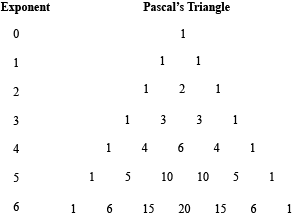Binomial Theorem
A way to expand binomials raised to a power without actually multiplying them out. It's like the math version of Cheat Mode.
End Behavior
The way a graph of a polynomial looks at its "ends." Also describes how a polynomial shakes its booty on the dance floor. The graphs of even-degree polynomials have both ends going in the same direction, while odd-degree polynomials have one end "up" and one end "down."
Pascal's Triangle
A shortcut to find the coefficients of a binomial expansion. Looks like this:

Perfect Square Trinomial
A polynomial of the form
a2 + 2
ab +
b2.
Polynomial
An expression containing constants and variables in which the exponents on all variables must be positive whole numbers and all the coefficients must be real. They're like Algebra's premier pop group—they're pretty popular, is what we're saying.
Remainder Theorem
A handy lil' theorem that whispers into our ears, "When we divide a polynomial
P(
x) by
x –
a, the remainder is equal to
P(
a)." Yeesh; say it, don't spray it.
Root
A solution to an equation, a.k.a. a zero, where the graph crosses the
x-axis
Synthetic Division
A shortcut to dividing a polynomial by a binomial of the form of
x –
a. Start by sticking the coefficients from your polynomial along the top row of a box, then plop
a over to the left of the box.
Zero
A solution to an equation, a.k.a. a root, where the graph crosses the
x-axis
